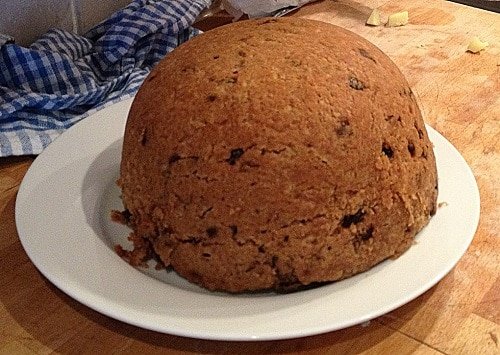
One of the most famous of the traditional British puds, a bowl of spotted dick with custard is proper comfort food. A tasty combination of suet dough, currants or other dried fruit, and lemon juice, it’s not too sweet but just right. It’s also easy to make.
The Name
Let’s get it out of the way – the snickering or stifled giggles that come from visitors who are unfamiliar with the dish. Some restaurants have even renamed it to “Spotted Richard” or the incredibly boring “steamed sultana pudding”. For shame!
There have been a number of attempts to explain the name. The “spotted” is obvious. It refers to the sultanas that dot the pudding.
As for the “dick”, that’s where things get a little more uncertain. Many historians claim it comes from the word “dough” but that seems to be quite a step to me. “Dough” to “duff” is one thing but any further is a stretch. I tend to agree with the explanation offered by The Straight Dope. They suggest that “dick” derives from “pudding” which was also often called “puddink” and later “puddick”. The article also notes that in the 1840s “dick” referred to a slab of hard cheese. Later, treacle was added to create a “treacle dick” although don’t ask me why! Then sultanas, and here we are today with the much loved spotted dick. (Although I’m still struggling with the concept of treacle sauce on cheese!)
The History

The first named recipe for spotted dick dates to 1845. Glyn Hughes, in his wonderful resource The Lost Foods of England, notes a recipe from Alexis Soyer’s A Shilling Cookery for The People. It consists of flour, suet, currants, sugar, cinnamon, eggs, and milk, all boiled in a cloth. However, just five years later, the same author (Soyer) offers a rather different recipe of a rolled dough spread with a paste. This, too, is boiled.
According to The Oxford Companion to Food, the original dish was a flat sheet of dough spread with sugar and raisins and then rolled into a log. Meanwhile, “spotted dog” was a similar roll of suet dough, but with the sultanas dotted on the outside.
The Recipe
Surprisingly, I had rather a hard time finding a recipe for spotted dick even in some of my most traditional cookbooks. Jamie Oliver’s recipe wasn’t one I liked the sound of – he added breadcrumbs. My books by Heston, Marguerite Patton, etc. all had nothing. Fortunately Dr. Neil Buttery came through for me. His recipe is perfect. Like him, I prefer a pudding that is steamed in a basin rather than rolled. He also has an excellent set of instructions for creating the foil wrap for the basin.

Some modern recipes opt for a baked pudding. I’ll stick with the traditional steaming, thanks. There are also a number of recipes opting for a quick steam in a pressure cooker or instant pot. I attempted this and was not overly satisfied with the results. By all means, try whichever method you prefer. As always, your mileage may vary!
Spotted Dick
300g self-raising flour
150g suet
75g sugar
100g currants or sultanas (I also added some leftover candied peel from Christmas. Chopped dates could be good.)
2 lemons, zested
275-300 ml milk
Combine the flour, suet, sugar, dried fruit, and lemon zest. Pour in the milk and mix until you have a nice dough. Spoon into a greased 1 litre pudding basin. If the basin has its own lid, attach that. If not, create a lid out of double folded foil. Tie into place with kitchen twine. Neil Buttery also suggests making a handy-dandy foil handle for lifting in and out of the pan. Steam for about 2 hours.
Once done, carefully remove and turn the basin onto a plate.

Voila! Spotted Dick!
Many will insist that you must eat this with custard but if you prefer it with cream or a simple drizzle of evaporated milk, you won’t face any judgement here. However you eat it, enjoy.


